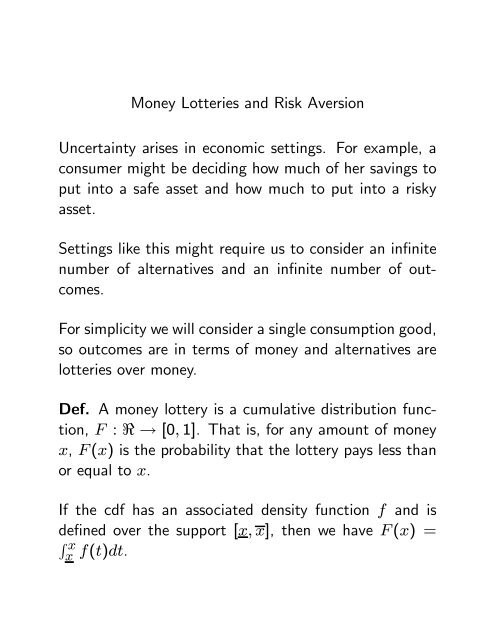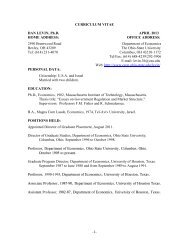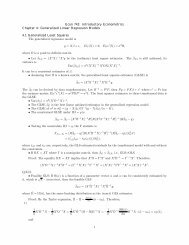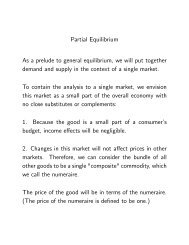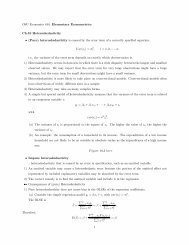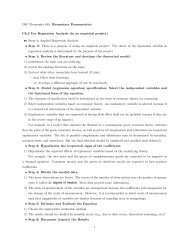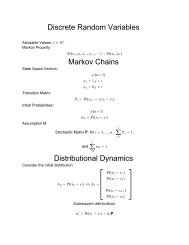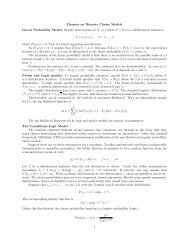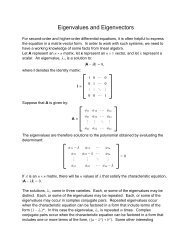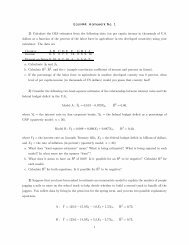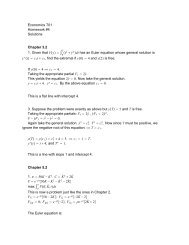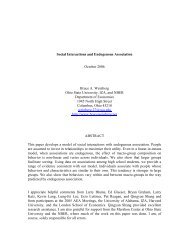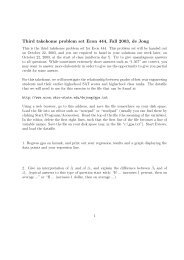Decision Making Under Uncertainty 2
Decision Making Under Uncertainty 2
Decision Making Under Uncertainty 2
You also want an ePaper? Increase the reach of your titles
YUMPU automatically turns print PDFs into web optimized ePapers that Google loves.
Money Lotteries and Risk Aversion<br />
<strong>Uncertainty</strong> arises in economic settings. For example, a<br />
consumer might be deciding how much of her savings to<br />
put into a safe asset and how much to put into a risky<br />
asset.<br />
Settings like this might require us to consider an infinite<br />
number of alternatives and an infinite number of outcomes.<br />
For simplicity we will consider a single consumption good,<br />
so outcomes are in terms of money and alternatives are<br />
lotteries over money.<br />
Def. A money lottery is a cumulative distribution function,<br />
: < → [0 1]. That is, for any amount of money<br />
, () is the probability that the lottery pays less than<br />
or equal to .<br />
If the cdf has an associated density function and is<br />
defined over the support [ ], thenwehave () =<br />
R <br />
().
For a compound lottery ( 1 ; 1 ),wecan<br />
convertitintoasimplelotterybycomputingthecdf<br />
based on the cdf’s for the underlying simple lotteries:<br />
() =<br />
X<br />
=1<br />
()<br />
We now take the space of lotteries L to be the space<br />
of distribution functions over nonnegative amounts of<br />
money, although specific environments may impose further<br />
restrictions on the support.<br />
The expected utility theorem (for continuous outcomes)<br />
says that, under continuity and independence, there is a<br />
utility function over outcomes, (), such that the utility<br />
of any lottery is given by<br />
( )=<br />
Z<br />
() ()<br />
(·) is the v.N-M expected utility function and (·) is<br />
called the Bernoulli utility function. We assume that (·)<br />
is strictly increasing (monotonic) and continuous.
Def. ADMisrisk averse if for any lottery , the degenerate<br />
lottery yielding the certain outcome R ()<br />
is weakly preferred to the lottery .IftheDMisalways<br />
indifferent between the two lotteries, she is risk neutral,<br />
and if R () withcertaintyisalwaysstrictlypreferred<br />
(unless is also degenerate) then the DM is strictly risk<br />
averse.<br />
Basedonthisdefinition, a v.N-M DM is risk averse if and<br />
only if<br />
Z<br />
Z<br />
() () ≤ ( ()) holds for all lotteries (·)<br />
The above inequality is called Jensen’s inequality, and it<br />
is true if and only if is a concave function.<br />
Thus, risk aversion is equivalent to the Bernouilli utility<br />
function being concave. Risk neutrality is equivalent to<br />
being linear.<br />
The word "aversion" makes sense, because the DM would<br />
not be willing to take a fair bet. (Draw a graph.)
Def. Given a Bernoulli utility function ,<br />
(i) The certainty equivalent of ,denotedby( ),<br />
is the amount of money for which the DM is indifferent<br />
between the lottery F and the certain amount solving<br />
() =<br />
Z<br />
() ()<br />
(ii) For any fixed amount of money and positive "bet"<br />
amount , theprobability premium, denoted by ( )<br />
is the excess in winning probability (above the fair odds of<br />
05) that makes the DM indifferent between the certain<br />
outcome and the gamble between the outcomes + <br />
and − . Thatis,( ) solves<br />
() =( 1 2 + )( + )+(1 − )( − )<br />
2
Proposition: Suppose a DM is an expected utility maximizer<br />
with a Bernoulli utility function over money, (·).<br />
Then the following properties are equivalent:<br />
(i) the DM is risk averse,<br />
(ii) (·) is concave,<br />
(iii) ( ) ≤ R () for all (·)<br />
(iv) ( ) ≥ 0 for all .
Example (Insurance) DM has initial wealth . Loses <br />
w.p. and loses nothing w.p. 1 − . The Bernoulli<br />
utility function is the natural logarithm, () =log().<br />
The price per unit of insurance is . (if you buy units,<br />
you pay , and if you have a loss you collect )<br />
What is the optimal ?<br />
max(1 − )log( − )+ log( − − + )<br />
<br />
If the price of insurance is close enough to "fair odds,"<br />
then there is an interior solution solving the f.o.c.<br />
(1 − )<br />
(1 − ) = − <br />
− + (1 − ) <br />
Solving for , wehave<br />
∗ = <br />
−<br />
( − )(1 − )<br />
<br />
1 −
If ∗ 0, then the DM is at a corner in which she strictly<br />
prefers not to buy insurance.<br />
<strong>Under</strong> fair odds, the insurance payment per unit, ,equals<br />
the expected claim per unit, . Then ∗ = . TheDM<br />
eliminates all risk and consumes the expectation of her<br />
after-loss wealth, − .<br />
If , the DM chooses less than full insurance.<br />
What is the certainty equivalent of the original lottery<br />
with no insurance? Solve<br />
log() =<br />
Z<br />
log() ()<br />
= (1− )log( )+ log( − )<br />
= 1− ( − ) <br />
For example, if =1, = 3 4 ,and = 1 2 ,theexpection<br />
of the lottery is 5 8<br />
but the certainty equivalent is<br />
1<br />
2 .
With log utility, =1,and = 1 2<br />
, what is the probability<br />
premium? Solve<br />
log(1) = ( 1 2 + )log(3 2 )+(1 2 − )log(1 2 )<br />
0 = 1 2 log(3 )+ log(3)<br />
4<br />
= −<br />
1<br />
2 log(3 4 )<br />
log(3) ' 01309
Example (A Portfolio Problem) The DM has initial wealth<br />
and must decide how much to allocate to each of two<br />
assets.<br />
Asset 1 pays a safe return, so 1 units invested yields 1<br />
units of consumption.<br />
Asset 2 is a risky asset paying a higher expected return.<br />
2 units invested yields 2 units of consumption, where<br />
=3with probability 1 2 and =0with probability 1 2 .<br />
If the Bernoulli utility function over final consumption is<br />
() = 12 ,whatistheoptimalportfolio?<br />
subject to<br />
1 + 2 = <br />
max 1 2 (1 +3 2 ) 12 + 1 2 (1 +0 2 ) 12
Solving by either the Lagrangean method or substitution,<br />
we have<br />
1 = 2<br />
and 2 = 2 <br />
Final consumption is 2 when the risky asset return is<br />
high and 2<br />
when the risky asset return is zero.
Measures of Risk Aversion<br />
Def. The Arrow-Pratt coefficient of absolute risk aversion<br />
at is<br />
() =− 00 ()<br />
0 ()<br />
00 () is a measure of the curvature of the utility function,<br />
but is affected by linear transformations. This is why we<br />
divide by 0 ().<br />
A risk neutral person will have () =0.<br />
The exponential utility function () =− − has a<br />
constant coefficient of absolute risk aversion:<br />
− 00 ()<br />
0 () = −<br />
−−2 − =
Decreasing absolute risk aversion means that the amount<br />
of money the DM is willing to pay to eliminate a fair bet<br />
of $100 is decreasing in her wealth. Decreasing relative<br />
risk aversion means that the amount of money the DM is<br />
willing to pay to eliminate a fair bet of 10% of her wealth<br />
is decreasing in her wealth.<br />
Def. The coefficient of relative risk aversion at is<br />
() =− 00 ()<br />
0 ()<br />
Since () = () holds, it is clear that decreasing<br />
relative risk aversion implies decreasing absolute risk<br />
aversion. Why?<br />
(for ≥ 0) ex-<br />
The CES utility function () = 1−<br />
1−<br />
hibits constant relative risk aversion:<br />
− 00 ()<br />
0 () = )<br />
−(−−−1 −<br />
=
Representing <strong>Uncertainty</strong> by States of Nature<br />
The outcomes associated with a lottery are generated by<br />
some underlying cause: whether you have a car accident<br />
for the insurance example, whether the risky firm’s invention<br />
succeeds in the portfolio example.<br />
When we consider market economies with uncertainty,<br />
we must keep track of these underlying causes in order to<br />
know whether everyone’s lottery over consumption can<br />
be implemented at the same time. We call these causes<br />
states or states of nature. For example, the number of<br />
oranges that can be consumed in total depends on the<br />
state of nature.<br />
Knowing the state resolves all uncertainty faced by the<br />
DM, or more generally, faced by anyone in the economy.<br />
We denote the set of states by and an individual state<br />
by ∈ .<br />
The (objective) probability of state is .
Continuing to assume that there is only one commodity<br />
(money), a random variable representing state-contingent<br />
consumption is a function : → < + that maps states<br />
into monetary outcomes.<br />
Note that also defines a money lottery ,with () =<br />
P<br />
:()≤ .<br />
The random variable can be represented by the vector<br />
of state-contingent consumptions, ( 1 ).<br />
The v.N-M expected utility function is given by<br />
X<br />
=1<br />
( )<br />
For some applications, the utility function itself may depend<br />
on the state. For example, maybe in some states you<br />
require a life-saving operation costing $10 000. Thenwe<br />
can write utility of the form<br />
X<br />
=1<br />
( )
Subjective Probability<br />
In many applications, people can agree on the set of<br />
states of nature but disagree on the probabilities. Then<br />
two DMs can consider the same state-contingent allocation<br />
to define two different lotteries.<br />
Suppose a DM maximizes a utility function of the form<br />
P =1<br />
( ). Can we determine her subjective probabilities<br />
from her behavior? In general, NO.<br />
(Savage’s Thm) <strong>Under</strong> the continuity and independence<br />
axioms, and under the additional assumption that preferences<br />
over money lotteries do not depend on the state,<br />
then preferences can be represented by an expected utility<br />
function of the form P <br />
=1 ( ) and the subjective<br />
probabilities are uniquely determined.
A Violation of Subjective Expected Utility: Ellsberg<br />
Paradox<br />
Supposethereare2urns. Inurn1,thereare50 red balls<br />
and 50 black balls. In urn 2, there are red balls and<br />
100 − black balls, but is not known.<br />
If the DM "bets" correctly, she receives $100, and otherwise<br />
she receives nothing.<br />
The typical DM strictly prefers a bet that a ball randomly<br />
drawn from urn 1 is red, to a bet that a ball randomly<br />
drawn from urn 2 is red (or black).<br />
Atthesametime,theDMisindifferent between a bet<br />
of red or black from urn 1, and the DM is indifferent<br />
between a bet of red or black from urn 2.<br />
These preferences exhibit ambiguity aversion, andareinconsistent<br />
with having subjective probabilities.


